
Click here for a higher resolution (larger) schematic.

Introduction:
The design of the audio power amplifier was dictated by the output transformer
I had on hand. The transformer was a high quality United Transformer S-14
universal output transformer. As shown in the catalog page below, taken from a
1950 Harrison Radio Catalog, the transformer could handle 10W of audio, had a
wide variety of input and output taps, and came in an attractive gray case that
would look great with the 6x2.
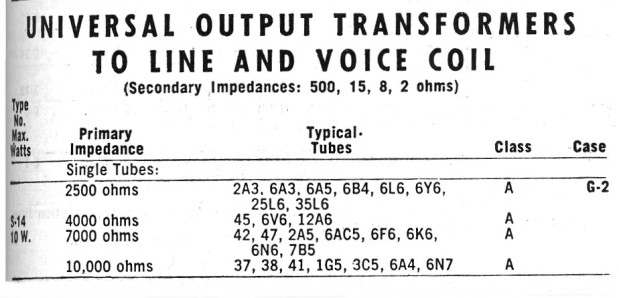
S-14 Output Transformer Listing from a 1950 Harrison Radio Catalog
The tubes listed in the table do not include miniature tubes, the type that
are used in the 6x2 receiver. These tubes were not yet in wide use in 1950.
However, the 6AQ5 is a 7-pin miniature tube that is the electrical equivalent
of the 6V6, which is listed above.
The 6AQ5 is a remarkable tube. With 250V on the plate it is capable of a power
output of 4.5W, which is quite large considering its size. 4.5W is a large
amount of power for a communications receiver, since many only have an output
of 1-2W. A distinct advantage of the 6AQ5 is that the screen grid voltage is
the same as the plate voltage, so a screen dropping resistor is not needed.
Typical operating conditions are given in the 6AQ5 data
sheet, and these were used in the 6x2 receiver. With the actual plate
voltage in the 6x2 receiver, which turned out to be a little less than 250V,
the audio power amplifier can produce an output of about 4W. From actual tests
it was determined that the 7000 ohm tap worked the best with the 6AQ5, rather
than the 4000 ohm tap listed for the 6V6.
Audio Power
Amplifier
Click On A Section of the Schematic
Below for Information on That Part of the Circuit:

| Input from First Audio Amplifier: Audio input to the audio power amplifier comes from the first audio amplifier. The first audio amplifier is a voltage amplifier which builds up the signal voltage to a point where it can properly drive the audio power amplifier. |
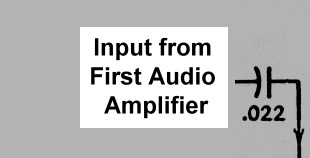 |
| Input Coupling Capacitor: The input coupling capacitor allows audio from the output of the first audio amplifier to pass through, while blocking the DC voltage on the plate of the first audio amplifier tube. The input coupling capacitor also serves as the output coupling capacitor for the first audio amplifier. |
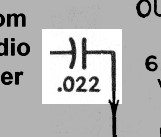 |
| Grid Resistor: The grid resistor allows the DC bias developed by the cathode bias resistor to reach the grid of the tube. |
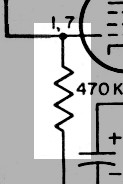 |
| Cathode Bias Resistor: Current flowing through the cathode bias resistor produces a voltage drop that is used to bias the tube. The cathode bias capacitor is connected across the resistor to smooth out any variations in the current and provide steady bias for the tube. |
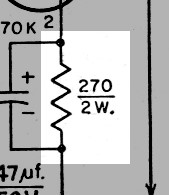 |
| Cathode Bias Capacitor: The cathode current flowing through the cathode bias resistor contains an AC component that must be shunted around the cathode bias resistor. The cathode bias capacitor shunts the AC component around the cathode bias resistor and smooths the voltage variations across the resistor, producing steady bias for the tube. |
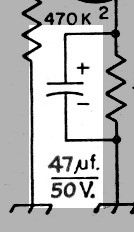 |
| 6AQ5 Vacuum Tube: The 6AQ5 is the miniature version of the popular 6V6 octal tube. A beam power tube, It is capable of an output of 4.5W, quite remarkable for its size. As configured in the 6x2 receiver, the actual output is 4W, much larger than the 1-2W typical of communications receivers. You can click here for a 6AQ5 Tube Data Sheet |
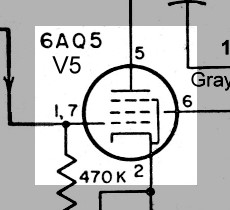 |
| Output Transformer: The output transformer matches the high, 5000 ohm load impedance of the 6AQ5 tube to the low, 8 ohm impedance of the speaker or headphones. The transformer used in the 6x2 receiver is a high quality S-14 universal output transformer made by United Transformer. |
 |
|
Transformer Bypass Capacitor: To prevent spurious high frequency audio oscillations, a 0.003uf capacitor is connected across the transformer primary. |
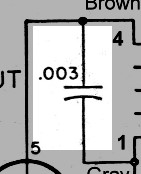 |
| B+: The audio power amplifier operates off of the B+ supply, which is nominally 250V in the 6x2 receiver. |
 |
 Back to Dr.
Greg Latta's Electrical Engineering and Amateur Radio Pages
Back to Dr.
Greg Latta's Electrical Engineering and Amateur Radio Pages
 If you have any questions or
comments, you can send E-Mail to Dr. Greg Latta at
glatta@frostburg.edu
If you have any questions or
comments, you can send E-Mail to Dr. Greg Latta at
glatta@frostburg.edu